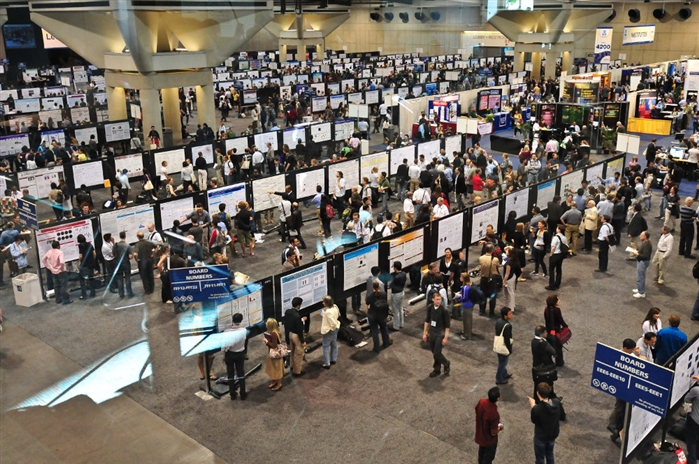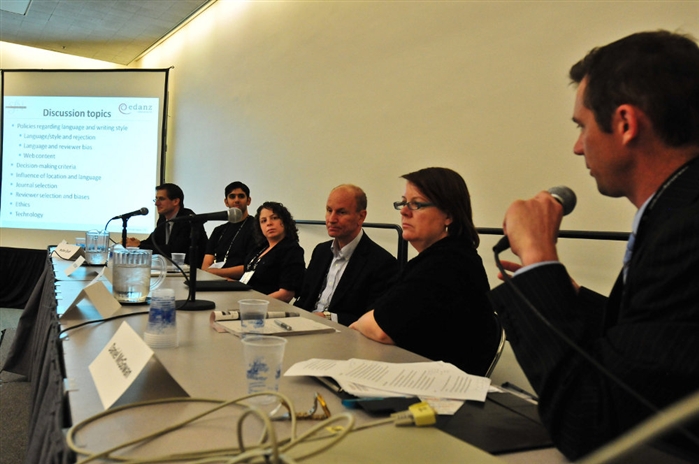博文
神经学会2010年圣地亚哥年会
|||
神经学会2010年度年会于本月13号至17号在圣地亚哥召开,理文编辑学术总监Dr Daniel McGowan先生应邀在分会上做报告,并与学术界和出版界的同行进行了深入的交流。下面,Dr McGowan将与大家分享此次会议的见闻和心得,有兴趣的朋友可以通过帖子下方的链接下载会议演讲材料。

此次大会规模如以往一样庞大,与会人数超过了31,000位。

到场听众300余位,挤满了整个会场

理文编辑学术总监Dr Daniel McGowan先生做题为“How to Write a Manuscript”的报告

Q&A环节反响热烈
与优秀的期刊编辑进行小组讨论,主题是母语非英语的科研人员在发表文章的过程中所遇到的问题以及期刊对此所作出的努力,来自Neuron, Nature Neuroscience, Neuroscience, Plos Biology的编辑参与了讨论。
※会议见闻※
The Society for Neuroscience Annual Meeting for 2010 was as hectic as always, with over 31,000 attendees, but it provided a great opportunity to catch up with clients, other researchers, publisher partners, journal editors, former colleagues and their associates, and of course to see some of the new and exciting developments in the very broad field of neuroscience.
For me, the main focus for the meeting was the workshop I was hosting on the Sunday morning. With no way of knowing in advance how many of the meeting’s attendees would be interested in a workshop on how to write a scientific paper, it was a relief and an affirmation of the extensive work we at Edanz have been doing in this area (educating authors on the process of writing a paper and getting it accepted) to have over 500 people turn up for the workshop. Unfortunately, the maximum room capacity of 300 people meant that many missed out, but those who were patient and queued in the hallway were admitted as some people left after the lecture.
The feedback received after the workshop was very positive, with invitations to Poland, Brazil and other countries to deliver similar content forthcoming. A mantra of mine when talking to researchers is that “the research isn’t over until it is published” and the high demand for advice on how to get work published shows that this is becoming widely understood. As well as the initial lecture, the workshop consisted of a panel discussion and question and answer session with the audience, and I am extremely grateful to all of the panelists who took part in this: Katja Brose, Editor of Neuron; Steve Lisberger, Chief Editor of Neuroscience; Hannah Bayer, Senior Editor on Nature Neuroscience; Ruchir Shah, Associate Editor on PLoS Biology; and Greg Tananbaum, CEO and Founder of Anianet, an online network connecting Chinese scientists to western peers.
Their contributions added tremendous value to the workshop, providing insight into how the editors of top journals make decisions on manuscripts, how they treat poorly written manuscripts and manuscripts from authors at foreign institutes without the reputation of some US and UK institutes, and how they choose and manage reviewers, among many other topics. It was very reassuring to hear from the editors that even poorly written papers are assessed based on the quality of the science, and that institute of origin and English writing ability have no influence on the decisions made. However, Greg Tananbaum and I were both quick to point out that the perception of our clients and Anianet members is that these factors do affect the decisions of editors, and this was confirmed by some of the responses from the audience during the question and answer session. The discussion on these topics revealed a large gap between the perception of authors in non-English-speaking countries and the actual policies of journal editors that will need to be narrowed through increased dialogue and education. More workshops of a similar nature will hopefully help to achieve that.
I had many good meetings at the conference and enjoyed catching up on progress in neuroscience research. In my old field of neurodegenerative diseases, it was interested to see how much Alzheimer’s research is now focused on inflammatory processes (from just a small number of posters and presentations a few years ago to whole symposia) and how many interactions among disease-linked proteins have been discovered, suggesting common pathways to disease. One highlight was the special Presidential Lecture on the use of deep brain stimulation to treat depression, a new application of an existing method (previously used to treat Parkinson’s disease and dyskinesias) to a problematic disorder.
If you were at the meeting, I hope you enjoyed the scientific content and networking opportunities it presented; if you came to the manuscript writing workshop, I hope you found it useful and that, at least for some, we can come and present in your institutes or departments. I am looking forward to next year’s meeting already.
※会后随想※
As my flight departed San Diego following the recent Society for Neuroscience Annual Meeting for 2010, I couldn’t help but overhear the conversation of the two people seated behind me. One was a Chinese researcher with her own lab in New Zealand; the other was an Indian researcher based in Australia. I largely ignored their discussion of the meeting and their own research, but became interested as the conversation turned to the importance of getting work published; after all, I had just a few days earlier hosted a workshop at the same meeting on this exact topic.
The Chinese researcher told the other that she had published several papers in journals like Neuroscience, the Journal of Neuroscience and the Journal of Neurochemistry. However, she regretted that she hadn’t yet managed to publish any work in a journal like Neuron or Nature Neuroscience. The two agreed that getting published in those journals depended on more than just the results—both felt that being able to write well and coming from a good lab were important factors.
This sentiment is one we often hear from our clients, yet it is contrary to the unanimous comments of all four of the journal editors that sat on the panel at the workshop I hosted revealing a gap between the perceptions of authors, particularly those for whom English is not the native language, and the practices of top journal editors. I believe the editors when they say they do not discriminate against authors on the basis of language or the country or institute in which they work—it would be terrible if they did, and I am sure they make every effort to assess papers honestly on the basis of the results presented. However, they are more likely to understand the key findings of a paper and their significance if these are clearly communicated. So while native language might not play a direct role in the decision-making process, it could play an indirect role, as an ability to clearly communicate research findings (an ability that is also lacking in many native English-speaking researchers) is clearly an advantage.
Hopefully, with a greater understanding of how much work needs to go into a paper targeted to a top journal, and what messages need to be clearly communicated, more authors from non-English-speaking countries will get their work published in such journals, thereby narrowing the gap between perception and practice. A great piece of advice from one of the panelists at the workshop was for researchers to study papers published in the target journal and compare the number and type of findings described, along with the ways in which these are described, with those being described in the researcher’s own manuscript. To put it simply, authors should try to emulate other authors whose work is being published in top journals.
The conversation behind me on that flight out of San Diego reminded me why we need to continue to present lectures on workshops on how to write scientific manuscripts. We still have a lot of work to do, with a lot of potential authors in a large number of countries, but we are committed to helping authors get their work published and look forward to working with such authors to prevent similar conversations and misperceptions in the future.
请访问理文编辑专门为此次大会制作的登录页面以下载相关材料。
https://wap.sciencenet.cn/blog-288924-386334.html
上一篇:Michal Lipson won a MacArthur “genius” grant
下一篇:单点课程之摘要